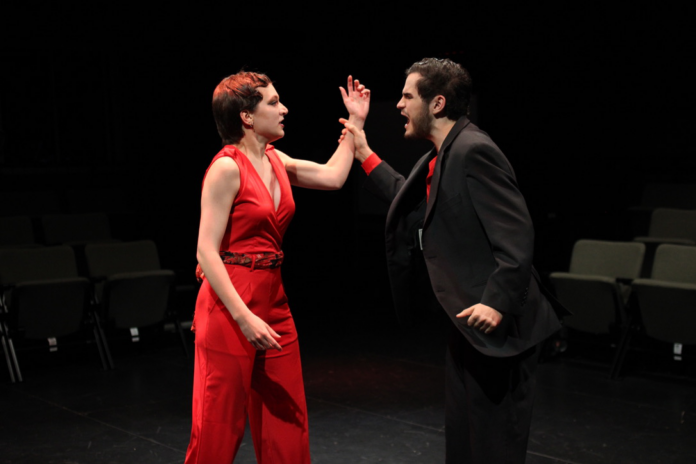In the Elizabethan Era when Shakespeare wrote, a woman’s subservience was seen as a measure of her desirability as the ideal wife. Shakespeare in the Dark, a student-run theater company at the College of William and Mary, addressed this norm and the complex dynamics of marriage, abuse and gender roles through their rendition of “The Taming of the Shrew.” The play opened Saturday, April 19 in the Lab Theater of Phi Beta Kappa Memorial Hall.
Director Cate Oken ’27 brought new life into this classic while preserving Shakespeare’s work. Oken began envisioning her unique interpretation of “The Taming of the Shrew” as a tragedy about a year and a half ago. After six weeks of intense production this spring, SItD brought her vision to the stage.
The blend of tragedy and comedy was skillfully executed by the actors who further contributed to the overall depth of the play. Kat Blackwood ’27 and Jack Baisch ’26 played the lead roles of Katharina and Petruchio respectively. Both delivered intense, captivating performances, doing their roles justice. Blackwood enthralled the audience with her portrayal of the hot-headed Katherina, characterized as the untamable “shrew.”
The play’s dilemma arises when Katherina’s younger sister Bianca, played by Meredith Starkenburg ’28, has many suitors eager to marry her. Their mother, Baptista, played by Lucy Cross ’25, forbids Bianca to marry until Katherina marries first. Motivated by greed and wealth, Petruchio seeks out to wed the affluent but undesirable Katherina, ignoring any romantic connection. Egotistic, ambitious Petruchio finds pleasure in the challenge of transforming Katherina into an obedient wife.
Baisch, who played the manipulative Petruchio, delivered a chilling performance, managing to instill fear and a deep aversion of his character in the audience through his calculated deceit and emotional domination. Petruchio breaks down Katherina’s character in a systematic manner. He deprives her of food and feeds her delusions as means to weaken her physically and mentally, molding her into a woman deemed more acceptable by society. Baisch’s performance was even more powerful due to his conscious decision to humanize Petruchio and bring light to what real abusers are like.
“This character had to be human, otherwise he wasn’t real, and he wasn’t representing the real people who abuse others,” Baisch said.
Baisch was so exceptional at his role I found myself enraged by his deceit. The same level of immersion was achieved by the entire cast and their ability to intricately tap into their characters with striking intensity and precision. The performance was so intense that actors practiced door exercises during rehearsals to reground themselves in reality. They would envision walking through a door one to enter their character, and depart from that door at the end of the rehearsal, leaving the emotional weight of their role behind.
It was efforts like these that sparked my newfound appreciation for the art of theatre, especially since “The Taming of the Shrew” marked the first live performance I have seen while in college. The play was immersive due to the actors’ ability to interact with the audience and connect through their performance, reviving a Shakesperian tradition of entertainment.
“You wouldn’t think of theater as so up close and personal—there’s the stage and there’s the audience—but it kind of blends that in a really interesting way,” lighting director Aislinh Kelley ’28 said.
The production also exposed audiences to real issues through an alternative lens. Oken aimed to shed light on themes of abuse and violence, and attempted to evoke the bystander effect in the audience. Meanwhile, the play’s comedic aspects provided plenty of humor. As a side plot, Bianca falls in love with the charming, comical Lucentio, played by Finley Cochran ’26. This deliberate intertwining of tragedy and comedy was crucial to captivate the audience while bringing attention to how distractions from uncomfortable realities are inevitable.
“I thought the comedy was not only necessary just to make the audience have a good laugh, but also to show that horrors can happen as lightness can happen and it can all kind of coalesce at the end,” Oken said.
Initially seen in a negative light as too combative and unladylike, characters’ perception of Katherina shifts after her marriage to Petruchio. Beneath her obstinate exterior lies a misunderstood woman with bitterness stemming from neglect. As her husband entrenches her deeper in her abusive marriage, her spirits fall and her defiance turns into desperation.
Blackwood drew the audience in with the show’s dramatic conclusion. As written, the show ends with a monologue by Katherina about the importance of a wife’s obedience. In SItD’s production, the stage fell silent and the lights went dark. Suddenly, Katherina frantically burst into the room, sobbing, her cries directed at the audience in a final plea for help. The room fell dark again.
“That final monologue is this complete release of identity, and from there it kind of turned into this piece on the bystander effect and psychological abuse,” Oken said.
Oken’s deep passion for theater was visible through her insightful direction and ability to preserve the play’s core vitality while injecting a bold twist that strays from the original, more upbeat ending. Setting the stage for the bystander effect that the audience is forced to confront, Oken aimed to delve into the play’s modern societal implications. Confronting the audience with the emotional toll of forced obedience brings to light the price of silence. Many audience members agreed the ending was their favorite scene.
Blackwood’s haunting portrayal of Katherina’s breakdown went beyond the performance itself and underscored the quiet collapse of losing oneself with heartbreaking subtlety. Unlike most Shakespeare tragedies, this performance didn’t end with a death, but the death of identity.

